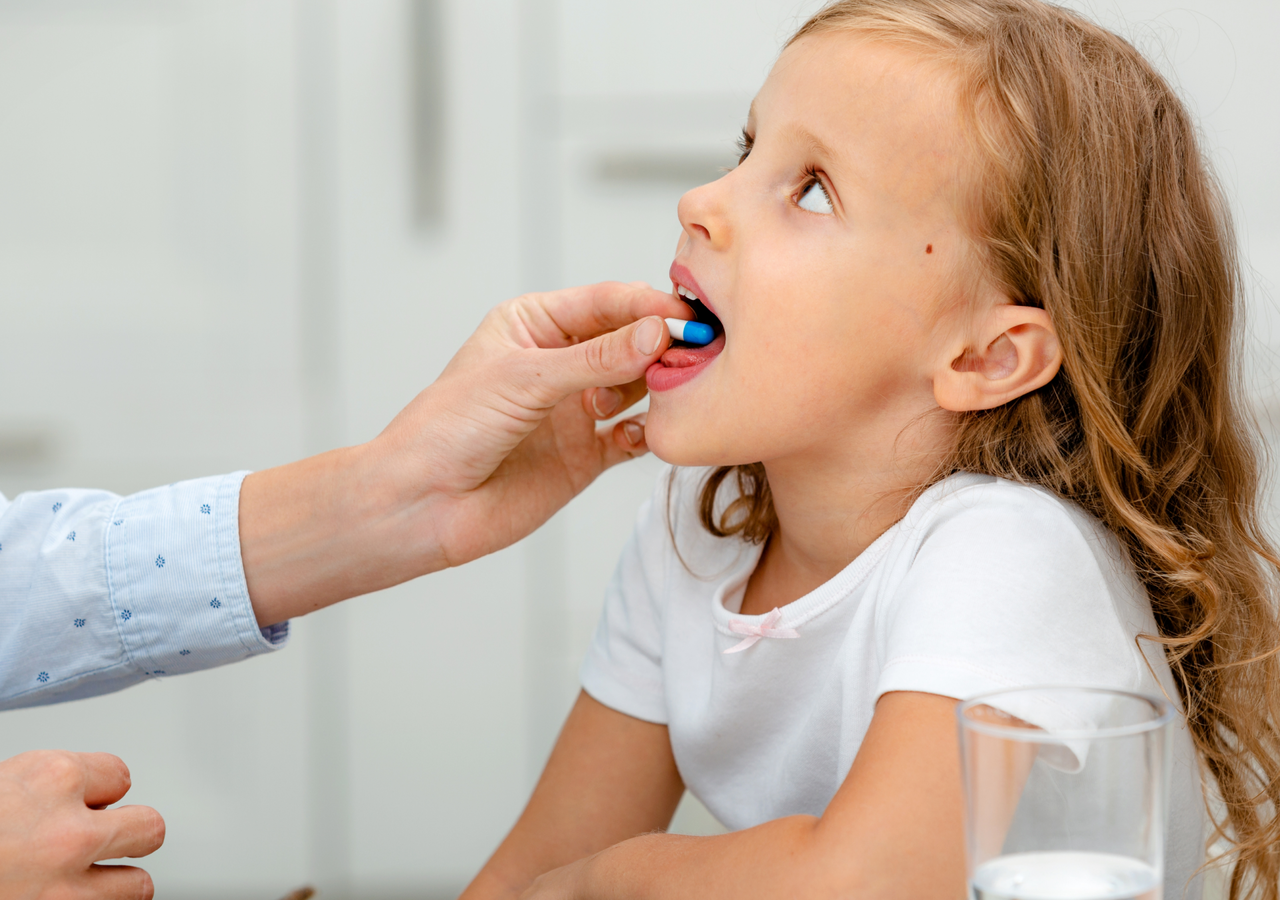How antibiotics affect your child’s health: What parents need to know
Written by: Alba Health team
Last updated: 2025-12-05

Summary
Antibiotics can be life-saving when your child faces a bacterial infection – but they can also disrupt the good bacteria that support digestion, immunity, and healthy development. In this guide, we explain what happens to your child’s gut during antibiotic treatment, how to make informed choices about when antibiotics are needed, and what you can do to help their microbiome recover naturally afterward.
Seeing your child sick is stressful. You want to make the best decisions for their health, and often that conversation involves antibiotics. These medications can be life-saving tools when fighting serious infections, but many parents worry about the side effects – specifically, how they affect the gut.
We know that antibiotics work by killing bacteria. The challenge is that they cannot always distinguish between the "bad" bacteria causing the infection and the "good" bacteria that keep your child healthy. This community of gut bacteria, or microbiome, is essential for digestion, immunity, and overall development.
The goal isn't to avoid antibiotics at all costs, but to use them wisely. By understanding how they work, you can feel confident in your medical choices and take simple, science-backed steps to support your child’s gut during and after treatment.
Why gut health matters during treatment
Your child’s gut is home to trillions of bacteria that act as a training ground for their immune system. When antibiotics disrupt this balance, it can have both immediate and lasting effects.
Short-term impact
- Loss of good bacteria: Essential helpers like Bifidobacterium can be significantly reduced. For instance, common treatments like amoxicillin may lower these beneficial levels temporarily.
- Digestive upset: It is common to see loose stools, diarrhea, or tummy pain as the microbiome shifts.
- Imbalance: Broad-spectrum antibiotics can wipe out a wide range of bacteria, leaving an "open space" where unwanted bacteria might grow.
Long-term health links
Research suggests that disrupting the gut balance in the first few years of life can be linked to health trends later on.
- Asthma and allergies: Early antibiotic use is associated with a higher risk of asthma and allergic conditions, likely because the gut plays a key role in teaching the immune system how to react safely.
- Weight and metabolism: Some studies have found connections between frequent antibiotic use in infancy and weight gain in childhood.
- Inflammation: Emerging evidence links early gut disruption to inflammatory conditions later in life, though research is still ongoing.

When antibiotics are the right choice
Despite the side effects, antibiotics are a vital part of modern medicine. There are many situations where the benefit of treating an infection far outweighs the risk to the microbiome.
- During pregnancy: Treating infections like urinary tract infections in mothers is critical to protect the developing baby.
- During labor: Antibiotics are often given during birth to prevent Group B Streptococcus (GBS) from passing to the newborn.
- Infancy: Babies – especially those born prematurely – may need antibiotics to treat serious respiratory or skin infections that their developing immune systems cannot fight alone.
- Childhood bacterial infections: As children grow, antibiotics remain the gold standard for treating confirmed bacterial infections like strep throat or pneumonia. Treating these promptly prevents serious complications and supports safe recovery.
Broad vs. narrow: Understanding the difference
Not all antibiotics work the same way. Knowing the difference can help you ask better questions at the doctor’s office.
Broad-spectrum antibiotics
Think of these as a "wide net." They are used when the specific bacteria causing the illness is unknown, or to cover many bases at once.
- Examples: Macrolides (like azithromycin) and Cephalosporins.
- Impact: Because they target a wide variety of bacteria, they tend to cause a larger disruption to the gut microbiome.
Narrow-spectrum antibiotics
Think of these as a "sniper." They are designed to target specific types of bacteria.
- Examples: Penicillins (like amoxicillin).
- Impact: Because they are more targeted, they generally leave more of the healthy gut ecosystem intact compared to broad-spectrum options.
How they work (simply put)
The science behind this is actually quite straightforward. Think of antibiotics as having different specific "weapons":
- Breaking the walls: Some medicines (like penicillin) stop bacteria from building strong cell walls, causing them to fall apart.
- Stopping growth: Others (like erythromycin) block the bacteria from making the proteins they need to grow and multiply.

Simple ways to support recovery
If your child needs antibiotics, you are not helpless. You can take active steps to protect and rebuild their gut health.
1. Continue breastfeeding if possible
If you are breastfeeding, keep going. Breast milk contains special sugars called Human Milk Oligosaccharides (HMOs). These sugars feed the beneficial Bifidobacteria in your baby's gut, helping to restore balance naturally.
2. Consider a probiotic
Giving a probiotic supplement during or after a course of antibiotics can help maintain the population of good bacteria.
- What to look for: Strains like Lactobacillus rhamnosus or Bifidobacterium are often recommended.
- Timing: If giving probiotics during the antibiotic course, try to space them out (e.g., give the probiotic 2–3 hours after the antibiotic dose) to give the good bacteria a fighting chance.
3. Focus on fiber and nutrition
For older children or formula-fed babies, diet is a powerful tool.
- Formulas: Look for options with added prebiotics (often listed as GOS/FOS).
- Solids: Once your child is eating food, focus on fiber-rich options like bananas, oats, and berries. These act as fertilizer for the good bacteria already in the gut.
4. Get a clear picture with Alba
Every child’s gut responds differently. Instead of guessing which foods or probiotics might help, Alba’s child gut health test allows you to see the actual impact on your child’s bacteria levels. You receive a detailed analysis and a personalized plan from a nutrition coach to help rebuild their gut diversity effectively.
Summary
- Antibiotics are tools: They are essential for treating serious infections but can disrupt the gut microbiome.
- Ask questions: "Broad-spectrum" antibiotics tend to impact the gut more than "narrow-spectrum" ones. Ask your doctor if a targeted option is available.
- The early window matters: The first few years of life are critical for gut development, so use antibiotics only when necessary.
- You can support recovery: Breastfeeding, probiotics, and fiber-rich foods can help the gut bounce back. For tailored guidance, Alba Health can map your child's specific needs.
[1] K. Korpela et al., "Intestinal microbiome is related to lifetime antibiotic use in Finnish pre-school children," Nature Communications, vol. 7, 2016, doi: 10.1038/ncomms10410.
[2] C. Jian, N. Carpén, O. Helve, W. M. de Vos, K. Korpela, and A. Salonen, "Early-life gut microbiota and its connection to metabolic health in children: Perspective on ecological drivers and need for quantitative approach," EBioMedicine, vol. 69, 2021, doi: 10.1016/j.ebiom.2021.103475.
[3] H. Neuman, P. Forsythe, A. Uzan, O. Avni, and O. Koren, "Antibiotics in early life: dysbiosis and the damage done," FEMS Microbiology Reviews, vol. 42, no. 4, pp. 489–499, 2018, doi: 10.1093/femsre/fuy018.
[4] W. M. De Vos, H. Tilg, M. Van Hul, and P. D. Cani, "Gut microbiome and health: Mechanistic insights," Gut, pp. 1020–1032, 2022, doi: 10.1136/gutjnl-2021-326789.
[5] K. Hou et al., "Microbiota in health and diseases," Signal Transduction and Targeted Therapy, vol. 7, no. 1, 2022, doi: 10.1038/s41392-022-00974-4.
[6] J. L. Round and S. K. Mazmanian, "The gut microbiome shapes intestinal immune responses during health and disease," Nature Reviews Immunology, vol. 9, no. 5, pp. 313–323, 2009, doi: 10.1038/nri2515.
[7] Y. Jiao, L. Wu, N. D. Huntington, and X. Zhang, "Crosstalk between gut microbiota and innate immunity and its implication in autoimmune diseases," Frontiers in Immunology, vol. 11, no. February, pp. 1–15, 2020, doi: 10.3389/fimmu.2020.00282.
[8] F. Fouhy et al., "High-throughput sequencing reveals the incomplete, short-term recovery of infant gut microbiota following parenteral antibiotic treatment with ampicillin and gentamicin," Antimicrobial Agents and Chemotherapy, vol. 56, no. 11, pp. 5811–5820, 2012, doi: 10.1128/AAC.00789-12.
[9] K. Korpela et al., "Antibiotics in early life associate with specific gut microbiota signatures in a prospective longitudinal infant cohort," Pediatric Research, vol. 88, no. 3, pp. 438–443, 2020, doi: 10.1038/s41390-020-0761-5.
[10] A. Uzan-Yulzari et al., "Neonatal antibiotic exposure impairs child growth during the first six years of life by perturbing intestinal microbial colonization," Nature Communications, vol. 12, no. 1, 2021, doi: 10.1038/s41467-020-20495-4.
[11] J. Penders, I. Kummeling, and C. Thijs, "Infant antibiotic use and wheeze and asthma risk: A systematic review and meta-analysis," European Respiratory Journal, vol. 38, no. 2, pp. 295–302, 2011, doi: 10.1183/09031936.00105010.
[12] S. Akagawa and K. Kaneko, "Gut microbiota and allergic diseases in children," Allergology International, vol. 71, no. 3, pp. 301–309, 2022, doi: 10.1016/j.alit.2022.02.004.
[13] L. Hoskin-Parr, A. Teyhan, A. Blocker, and A. J. W. Henderson, "Antibiotic exposure in the first two years of life and development of asthma and other allergic diseases by 7.5 years: A dose-dependent relationship," Pediatric Allergy and Immunology, vol. 24, no. 8, pp. 762–771, 2013, doi: 10.1111/pai.12153.
[14] C. M. Stark, A. Susi, J. Emerick, and C. M. Nylund, "Antibiotic and acid-suppression medications during early childhood are associated with obesity," Gut, vol. 68, no. 1, pp. 62–69, 2019, doi: 10.1136/gutjnl-2017-314971.
[15] S. A. Miller, R. K. S. Wu, and M. Oremus, "The association between antibiotic use in infancy and childhood overweight or obesity: A systematic review and meta-analysis," Obesity Reviews, vol. 19, no. 11, pp. 1463–1475, 2018, doi: 10.1111/obr.12717.
[16] L. Virta, A. Auvinen, H. Helenius, P. Huovinen, and K. Kolho, "Association of repeated exposure to antibiotics with the development of pediatric Crohn’s disease—A nationwide, register-based Finnish case-control study," American Journal of Epidemiology, vol. 175, no. 8, pp. 775–784, 2012, doi: 10.1093/aje/kwr400.
[17] J. Stokholm et al., "Antibiotic use during pregnancy alters the commensal vaginal microbiota," Clinical Microbiology and Infection, vol. 20, no. 7, pp. 629–635, 2014, doi: 10.1111/1469-0691.12411.
[18] D. B. Nelson, "Treatment and management of bacterial vaginosis in pregnancy: Current and future perspectives," Women’s Health, vol. 2, no. 2, pp. 267–277, 2006, doi: 10.2217/17455057.2.2.267.
[19] C. C. Ribeiro-do-Valle et al., "Aetiology and use of antibiotics in pregnancy-related infections: Results of the WHO Global Maternal Sepsis Study (GLOSS), 1-week inception cohort," Annals of Clinical Microbiology and Antimicrobials, vol. 23, no. 1, pp. 1–12, 2024, doi: 10.1186/s12941-024-00681-8.
[20] R. Jokela et al., "Quantitative insights into effects of intrapartum antibiotics and birth mode on infant gut microbiota in relation to well-being during the first year of life," Gut Microbes, vol. 14, no. 1, pp. 1–16, 2022, doi: 10.1080/19490976.2022.2095775.
[21] M. Reyman et al., “Effects of early-life antibiotics on the developing infant gut microbiome and resistome: a randomized trial,” Nature Communications, vol. 13, no. 1, pp. 1–12, 2022, doi: 10.1038/s41467-022-28525-z.
[22] H. Huang, J. Jiang, X. Wang, K. Jiang, and H. Cao, “Exposure to prescribed medication in early life and impacts on gut microbiota and disease development,” eClinicalMedicine, vol. 68, p. 102428, 2024, doi: 10.1016/j.eclinm.2024.102428.
[23] S. Tanaka et al., “Influence of antibiotic exposure in the early postnatal period on the development of intestinal microbiota,” FEMS Immunology & Medical Microbiology, vol. 56, no. 1, pp. 80–87, 2009, doi: 10.1111/j.1574-695X.2009.00553.x.
[24] N. A. Bokulich, J. Chung, T. Battaglia, and N. Henderson, “Antibiotics, birth mode, and diet shape microbiome maturation during early life,” Science Translational Medicine, vol. 8, no. 343, pp. 1–25, 2016, doi: 10.1126/scitranslmed.aad7121.
[25] J. Jaroszewski, N. Mamun, and K. Czaja, “Bidirectional Interaction between Tetracyclines and Gut Microbiome,” Antibiotics, vol. 12, no. 9, pp. 1–18, 2023, doi: 10.3390/antibiotics12091438.
[26] D. F. Pancu et al., “Antibiotics: Conventional therapy and natural compounds with antibacterial activity—a pharmaco-toxicological screening,” Antibiotics, vol. 10, no. 4, 2021, doi: 10.3390/antibiotics10040401.
[27] E. M. Halawa et al., “Antibiotic action and resistance: updated review of mechanisms, spread, influencing factors, and alternative approaches for combating resistance,” Frontiers in Pharmacology, vol. 14, no. January, pp. 1–17, 2023, doi: 10.3389/fphar.2023.1305294.
[28] A. Marcobal and J. L. Sonnenburg, “Human milk oligosaccharide consumption by intestinal microbiota,” Clinical Microbiology and Infection, vol. 18, no. SUPPL. 4, pp. 12–15, 2012, doi: 10.1111/j.1469-0691.2012.03863.x.
[29] K. Korpela and W. M. de Vos, “Infant gut microbiota restoration: state of the art,” Gut Microbes, vol. 14, no. 1, pp. 1–14, 2022, doi: 10.1080/19490976.2022.2118811.
[30] C. Milani et al., “The first microbial colonizers of the human gut: composition, activities, and health implications of the infant gut microbiota,” Microbiology and Molecular Biology Reviews, vol. 81, no. 4, pp. 1–67, 2017.
[31] K. Korpela et al., “Probiotic supplementation restores normal microbiota composition and function in antibiotic-treated and in caesarean-born infants,” Microbiome, vol. 6, no. 1, pp. 1–11, 2018, doi: 10.1186/s40168-018-0567-4.
[32] K. Korpela et al., “Maternal fecal microbiota transplantation in cesarean-born infants rapidly restores normal gut microbial development: a proof-of-concept study,” Cell, vol. 183, no. 2, pp. 324–334.e5, 2020, doi: 10.1016/j.cell.2020.08.047.
[33] G. Puccio et al., “Effects of infant formula with human milk oligosaccharides on growth and morbidity: a randomized multicenter trial,” Journal of Pediatric Gastroenterology and Nutrition, vol. 64, no. 4, pp. 624–631, 2017, doi: 10.1097/MPG.0000000000001520.
[34] K. C. Goehring, B. J. Marriage, J. S. Oliver, J. A. Wilder, E. G. Barrett, and R. H. Buck, “Similar to those who are breastfed, infants fed a formula containing 2’-fucosyllactose have lower inflammatory cytokines in a randomized controlled trial,” The Journal of Nutrition, vol. 146, no. 12, pp. 2559–2566, 2016, doi: 10.3945/jn.116.236919.
Support your child's gut after antibiotics
Alba's pioneering test helps you discover you child's gut health and guides you on how to improve it, with the help of a certified Nutrition & Health Coach.
Get started

